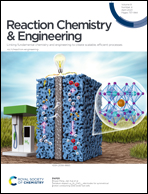An electron “donor–acceptor–donor” strategy to activate ZIF-67 as a cathode material for fuel cells and zinc ion hybrid supercapacitor†
Abstract
Rational design of non-precious and efficient electrocatalysts for oxygen reduction reactions (ORR) is of utmost importance for sustainable energy exploitation, solving the energy crisis and environmental danger. Herein, we report a work function tailored zeolite derived hierarchically porous and active site enriched electrocatalyst to study ORR in acidic and alkaline media and its application as a zinc ion hybrid supercapacitor (ZIHSC). The electrochemical analysis proposes that the optimized electrocatalyst with a high surface area, porosity and high active site density facilitates the electronic transfer from atomic cobalt (Co) to a nitrogen doped graphitic carbon framework (NGC) and, furthermore to the antibonding state of oxygen. The optimized catalyst AL-Co/NGC-800 shows a better ORR performance, with a remarkable onset potential (Eonset acid − 0.89 V, Eonset alkaline − 0.951 V) and a large active site density (ASDacid − 7.84 × 1023 g−1, ASDalkaline − 1.51 × 1024 g−1) together with excellent stability and durability. It is proposed that the catalyst's high performance is attributed to the reduction in work function (WFZIF-67 − 5.2 to WFoptimized − 4.6) as an effect of temperature followed by post ‘acid leaching’ (AL) treatment which alters the surface area of the catalyst. Owing of its promising ORR activity, the catalyst was further tested for a proton exchange membrane fuel cell (PEMFC) as a cathode catalyst which displays maximum power density of 18 mW cm−2 at a current density of 63 mA cm−2. The high surface area and micro porosity of the catalyst improves the cathode kinetics, thereby delivering a high capacitance of 190 F g−1 and a maximum energy density of 67.39 W h kg−1 with a power density of 242.64 W h kg−1 towards ZIHSC. Herein, we present a favorable strategy for the fabrication of a highly efficient and durable ORR catalyst with a promising energy density for its use in ZIHSCs. This hybrid structure provides a new perspective on catalyst architecture.



 Please wait while we load your content...
Please wait while we load your content...